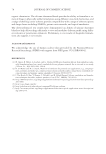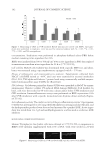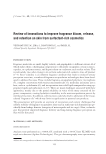JOURNAL OF COSMETIC SCIENCE 88 the fi nal state of a dynamic system is the result of both the boundary conditions (includ- ing the initial conditions) and its dynamic characteristics, we could expect to have a more reproducible maturated tissue thanks to 3D bioprinting. SKIN EQUIVALENT STUDY DESIGN To reproduce complex, heterogeneous functional tissues and organs found in the human body such as skin, understanding of composition and organization of their components is an essential requirement. PREBIOPRINTING This is the fi rst step to generate a 3D tissue fi le containing the 3D structure and compo- sition of the tissue to be bioprinted. This is the product of an ideation phase based on the observation of native tissues or imaging data and literature analysis regarding dermal and epidermal histometry. ImageMatrix is used to generate complex visual designs for tissue. The goal is to determine and design specifi c virtual micropatterns to engineer at fi rst a dermis then an epidermis onto the dermis. Dermis design. As the native dermis in the skin is mainly composed of collagen I and III, we used both collagen type I and a mixture of collagen type I and III (95–5%) to associate with normal human adult fi broblasts in our preliminary testing. ▪ The 3D structure was created by alternating a layer of collagen with a layer of cells. ▪ The cell pattern was chosen to ensure a uniform distribution of fi broblasts. Figure 3. (A) Printed dermis after 5 days, (B) epidermized printed dermis (keratinocytes manually depos- ited) after 15 days, and (C) printed skin after 14 days. Figure 2. Laser-assisted bioprinter benefi ts compared to other bioprinters (6).
NEW BIOPRINTED SKIN, COSMETIC IN VITRO MODEL 89 ▪ In each plane, the cell pattern was a square network with a characteristic distance of 300 μm between spot of cells. ▪ Number of layers is designed to print a minimal initial dermis thickness of 200 μm. Epidermis design. ▪ The epidermis basal layer was designed with pattern was chosen to ensure a uniform distribution of normal human adult keratinocytes. ▪ In each plane, the cell pattern was a square network with a distance of 100–300 μm between spot of cells. ▪ Number of layers is designed to reach a minimal initial epidermal basal layer thickness. BIOFABRICATION Two different technologies were combined to 3D print the dermis equivalent, a microvalve technology was used to print the collagen layers, whereas LaBP was used for the cell layers. Culture media for fi broblasts is a DMEM/F12 base containing antibiotics and 20% SVF for seeding then 10% during growth period. Green medium (7) supplemented by 50 μg/ml ascorbic acid and antibiotics is used for keratinocyte seeding and DMEM/F12 supple- mented by (0.8% BSA, 0.12 UI/ml insulin, 0.4 μg/ml hydrocortisone, 50 μg/ml ascorbic acid and antibiotics) for keratinocytes differentiation. Kinetic of dermis maturation was performed to defi ne the best timing for dermis mat- uration before epidermal printing. One active ingredient (Origanum majorana leaf extract 0.04%—BASF) was added in the culture media to evaluate the benefi t on dermis matura- tion extracellular matrix synthesis, dermal–epidermal junction quality) and quality of epidermal anchorage and differentiation. ANALYSIS Dermis and epidermis quality was studied by histology and immunostaining. Results were compared to human skin biopsies and in house skin equivalent performed manually (Mimeskin®). Bioprinted skin models are suitable for dermocosmetic evaluations and allows to observe some changes induced by the treatment with an O. majorana extract used at 0.04% (in the dermis: LOXL1 elastin cross-linking enzyme—in the epidermis: thickness and involucrin). Figure 4. Immunostaining of untreated and treated models after 14 days.
Purchased for the exclusive use of nofirst nolast (unknown) From: SCC Media Library & Resource Center (library.scconline.org)












































































































































